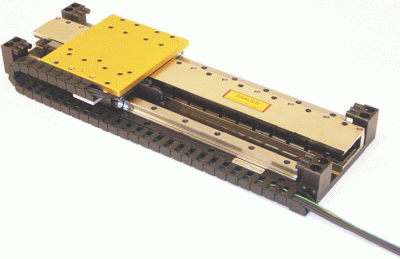E ectrical engineers are often required to specify linear drives and thus need to identify the best technology for any given application. Andy Parker-Bates of Parker Electromechanical weighs up the pros and cons of electromechanical, hydraulic and pneumatic technologies
ectrical engineers are often required to specify linear drives and thus need to identify the best technology for any given application. Andy Parker-Bates of Parker Electromechanical weighs up the pros and cons of electromechanical, hydraulic and pneumatic technologies
Electromechanical, hydraulic or pneumatic technology is the usual dilemma presented to most engineers when specifying a linear motion actuator. Each technology has its own strengths and weaknesses that need to be carefully considered in terms of the expected function for the actuator required, in order to provide the optimum solution.
Pneumatics – simple and fast
Pneumatic actuation relies on the conversion of compressed air into linear force. The interaction of pressure, volume, and temperature of a gas provides the resultant force that governs the use of pneumatics.
Pneumatic technology is simple to understand and has low cost associated with setting-up and running. It is often utilised in fully retracted or fully extended mode. However, it is also possible to incorporate a stepped motion or even infinitely controllable positioning if needed.
Typical applications include die casting, extrusion, injection moulding and precision machining. Pneumatics are favoured in extreme temperature environments, safety and inspection, and magnetic systems. Pneumatic actuators also don’t have the magnetic field issues of motors.
Recent improvements in pneumatic design have led to improved controllability and sealing to prevent contamination, while the development of material coatings now offers protection against caustic wash downs that has helped widen the scope further to applications including food processing and packaging sectors.
On the flip side, pressure losses and the compressibility of air can make pneumatics less efficient than other linear technologies, while limitations in delivery and compressor systems dictate that pneumatics operate at lower pressures.
Hydraulics – strength and control
Where greater power is necessary, hydraulic cylinders can generate incredible force and motion from relatively compact actuators. Their operation is based on pressure applied to an enclosed fluid and transmitted to the containing vessel. The amount of force applied by the cylinder is the product of the hydraulic input pressure multiplied by the area of the cylinder piston.
Typically, hydraulic applications can involve extremely heavy machinery such as swing bridges and heavy lift cranes, while in contrast, the same technology is light enough to be used in aerospace applications. Industrial hydraulics sit somewhere between these two extremes and is favoured for robust power and controllability.
However, hydraulic systems do require more equipment to run compared with pneumatics, while leaks can cause cleanliness issues and possible damage on other system components or products.
 Electromechanical – precision control and speed
Electromechanical – precision control and speed
Electromechanical technology offers the widest scope for linear drives and is suited where high precision and high controllability applications are required. It can cope with both high and low speed requirements and is excellent for multi-axis applications.
In particular, when driven by a motor in linear configuration it can achieve high dynamic performance with acceleration forces of greater than 20g at velocities of 10m per second and higher. The direct drive nature of linear motors means there are no mechanical components to add backlash, torsional wind-up, or other positioning errors to the system. With fewer components, reliability issues are lower, while performance can reach sub-micron resolution and repeatability.
Application demands dictate the type of motor most suitable. Motor types include iron core, ironless, slotless and piezomotors, and all have unique motion characteristics to consider.
In fact, there are a number of different mechanisms available to choose from, including four rotary to linear conversion systems – ball screw, roller screw, lead screw, or belt drive. The sub-divisions of all these systems are virtually limitless depending on speed, robustness, smoothness and precision required.
The main consideration of electromagnetic technology is the initial cost and the complexity of the build. Careful consideration must be given to the type of system best suited to the application needs and conditions. However, specialist engineers from the leading motion and control companies are well positioned to offer advice and help design and install electromechanical systems.
Power and energy supply
The power source and energy consumption for each of the linear motion technologies is worth considering. Not surprisingly, electromechanical actuators are driven by electric motors. Perhaps most commonly they use servo motors, which are highly dynamic and highly accurate, but they do come at a price.
Pneumatics are driven by compressed air and requires a compressor or compressor bank. These standard products are relatively cheap and compressed air supply is often readily available on-site.
Hydraulic systems require a power pack. These are normally built as part of, or an adjunct to, the installation and as such they have to be included in the cost. A basic power pack consists of a pump, oil reservoir and filter, but may also include secondary filters, instrumentation, a drip tray, a heat exchanger to cool the re-circulating oil and possibly an oil heater for use at start-up.
All of this may seem a long way from electrical engineering, but in practice engineers are increasingly called upon to work across several disciplines. However, with the right technical expertise and research, as well as considering levels of performance, functionality, budget, energy source and energy efficiency factors, the most appropriate solution can be found.

